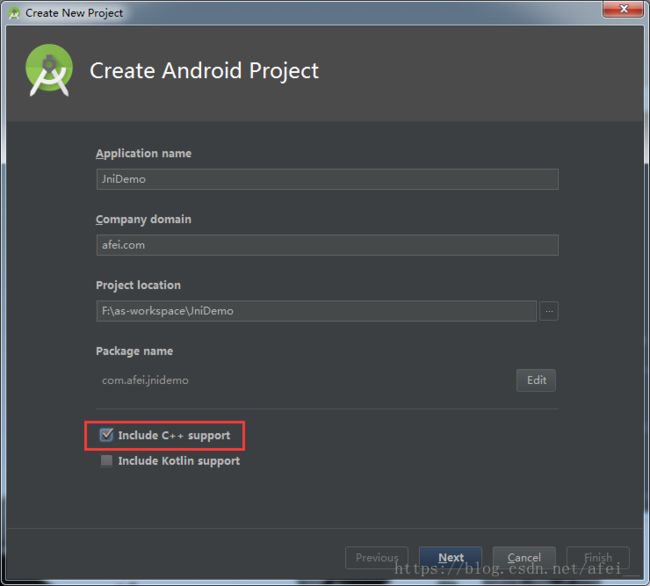NDK开发第一课:环境配置与第一个JNI程序
一、JNI 与 NDK
1. JNI 是什么
JNI 是 Java Native Interface 的缩写,即 Java 的本地接口。
目的是使得 Java 与本地其他语言(如 C/C++)进行交互。
JNI 是属于 Java 的,与 Android 无直接关系。
2. NDK 是什么
NDK 是 Native Development Kit 的缩写,是 Android 的工具开发包。
作用是快速开发 C/C++ 的动态库,并自动将动态库与应用一起打包到 apk。
NDK 是属于 Android 的,与 Java 无直接关系。
3. JNI 与 NDK 的关系
JNI 是实现的目的,NDK 是 Android 中实现 JNI 的手段。
二、NDK 的下载
1. 官网下载
地址为:https://developer.android.com/ndk/downloads/
下载后直接解压即可,注意路径名不能带有中文或者空格。
2. Android Studio 中下载
点开 Android Studio 的 SDK Manager 可以看到如下截图,这里我们选择下载红框中勾选的3个工具。
- CMake:一个跨平台的编译构建工具,替代 Android.mk
- LLDB:一个高效的 C/C++ 的调试工具
-
NDK:即我们需要下载的工具,会生成到 SDK 根目录下的 ndk-bundle 目录下
三、我的第一个 JNI 程序
1. 新建工程,并选择包含 C++ support,如下图所示
在接下来向导中的 Customize C++ Support 部分,您可以使用下列选项自定义项目:
- C++ Standard:使用下拉列表选择您希望使用哪种 C++ 标准。选择 Toolchain Default 会使用默认的 CMake 设置。
- Exceptions Support:如果您希望启用对 C++ 异常处理的支持,请选中此复选框。如果启用此复选框,Android Studio 会将
-fexceptions标志添加到模块级 build.gradle 文件的 cppFlags 中,Gradle 会将其传递到 CMake。 - Runtime Type Information Support:如果您希望支持 RTTI,请选中此复选框。如果启用此复选框,Android Studio 会将 -frtti 标志添加到模块级 build.gradle 文件的 cppFlags 中,Gradle 会将其传递到 CMake。
2. Android Studio 会自动帮你生成一个可执行的 Hello World 程序,我们简单看一下这个工程
相比平常的 Android 工程,这里主要是多了上面截图中红框处的文件。其中 cpp 目录就是我们的 C/C++ 代码、预编译库的默认路径了,而 CMakeList.txt 就是编译的脚本文件了。
接下来我们详细分析一下每一块的原理。
3. MainActivity
public class MainActivity extends AppCompatActivity {
// Used to load the 'native-lib' library on application startup.
static {
System.loadLibrary("native-lib");
}
@Override
protected void onCreate(Bundle savedInstanceState) {
super.onCreate(savedInstanceState);
setContentView(R.layout.activity_main);
// Example of a call to a native method
TextView tv = (TextView) findViewById(R.id.sample_text);
tv.setText(stringFromJNI());
}
/**
* A native method that is implemented by the 'native-lib' native library,
* which is packaged with this application.
*/
public native String stringFromJNI();
} 我们知道,Java 调用本地方法,是使用 native 关键字。而本例中,本地方法的实现是在一个叫做 “native-lib” 的动态库里(动态库的名称是在 CMakeList.txt 中指定的),要想使用这个动态库,就必须先加载这个库,即 System.loadLibrary(native-lib) 。这些都是 Java 的语法定义。
4. native-lib.cpp
#include
#include
extern "C" JNIEXPORT jstring
JNICALL
Java_com_afei_jnidemo_MainActivity_stringFromJNI(
JNIEnv *env,
jobject /* this */) {
std::string hello = "Hello from C++";
return env->NewStringUTF(hello.c_str());
} 上面提到的 public native String stringFromJNI() 方法的实现就是在这里,那怎么知道 Java 中的某个 native 方法是对应的 cpp 中的哪个方法呢?这就和 JNI 的注册有关了,本例中使用的是静态注册,即 “Java包名类名_方法名” 的形式,其中包名也是用下划线替代点号。
后续章节将详细介绍 JNI 方法的注册,以及参数的转换等。
5. 整个调用流程就是:
- Gradle 调用您的外部构建脚本 CMakeLists.txt。
- CMake 按照构建脚本中的命令将 C++ 源文件 native-lib.cpp 编译到共享的对象库中,并命名为 libnative-lib.so,Gradle 随后会将其打包到 APK 中。
- 运行时,应用的 MainActivity 会使用
System.loadLibrary()加载原生库。现在,应用可以使用库的原生函数stringFromJNI()。 - MainActivity.onCreate() 调用
stringFromJNI(),这将返回“Hello from C++”并使用这些文字更新 TextView。
四、 手动配置 gradle 支持 NDK 开发
要手动配置 Gradle 以关联到您的原生库,需要将 externalNativeBuild {} 块添加到模块级 build.gradle 文件中,并使用 cmake {} 或 ndkBuild {} 对其进行配置:
android {
...
defaultConfig {...}
buildTypes {...}
// Encapsulates your external native build configurations.
externalNativeBuild {
// Encapsulates your CMake build configurations.
cmake {
// Provides a relative path to your CMake build script.
path "CMakeLists.txt"
}
}
}注意:
如果您想要将 Gradle 关联到现有 ndk-build 项目,请使用 ndkBuild {} 块而不是 cmake {},并提供 Android.mk 文件的相对路径。如果 Application.mk 文件与您的 Android.mk 文件位于相同目录下,Gradle 也会包含此文件。
五、 CMakeLists.txt 简单分析
1. 首先我们看一下自动生成的 CMakeLists.txt 都有些什么内容
# For more information about using CMake with Android Studio, read the
# documentation: https://d.android.com/studio/projects/add-native-code.html
# Sets the minimum version of CMake required to build the native library.
cmake_minimum_required(VERSION 3.4.1)
# Creates and names a library, sets it as either STATIC
# or SHARED, and provides the relative paths to its source code.
# You can define multiple libraries, and CMake builds them for you.
# Gradle automatically packages shared libraries with your APK.
add_library( # Sets the name of the library.
native-lib
# Sets the library as a shared library.
SHARED
# Provides a relative path to your source file(s).
src/main/cpp/native-lib.cpp )
# Searches for a specified prebuilt library and stores the path as a
# variable. Because CMake includes system libraries in the search path by
# default, you only need to specify the name of the public NDK library
# you want to add. CMake verifies that the library exists before
# completing its build.
find_library( # Sets the name of the path variable.
log-lib
# Specifies the name of the NDK library that
# you want CMake to locate.
log )
# Specifies libraries CMake should link to your target library. You
# can link multiple libraries, such as libraries you define in this
# build script, prebuilt third-party libraries, or system libraries.
target_link_libraries( # Specifies the target library.
native-lib
# Links the target library to the log library
# included in the NDK.
${log-lib} )2. cmake_minimum_required
指定 Cmake 需要的最低版本
3. add_library
创建和命名该库,第一个参数是库的名字,例如取名为 native-lib,将会生成一个命名为 libnative-lib.so 的库。
第二个参数是指定库的类型,一般为 SHARED,即动态库(以 .so 为后缀),还有一种是静态库 STATIC,即静态库(以 .a 为后缀)。
第三个参数是指定该库使用的源文件路径。
使用多个 add_library() 命令,您可以为 CMake 定义要从其他源文件构建的更多库。
4. find_library
找到一个 NDK 的库,并且将这个库的路径存储在一个变量中。例如上例中是找到 NDK 中的 log 库(Android 特定的日志支持库),并将其路径存储在 “log-lib” 变量中,在后面你就可以通过 “${log-lib}” 命令取出变量中的值了。
5. target_link_libraries
关联库。将指定的库关联起来 。
6. 注释应该基本也能看得懂,关于 CMake 的更多语法,将在后续章节介绍。
博客链接:CMakeLists.txt 语法介绍与实例演练
其它:
NDK 学习系列:Android NDK 从入门到精通(汇总篇)


